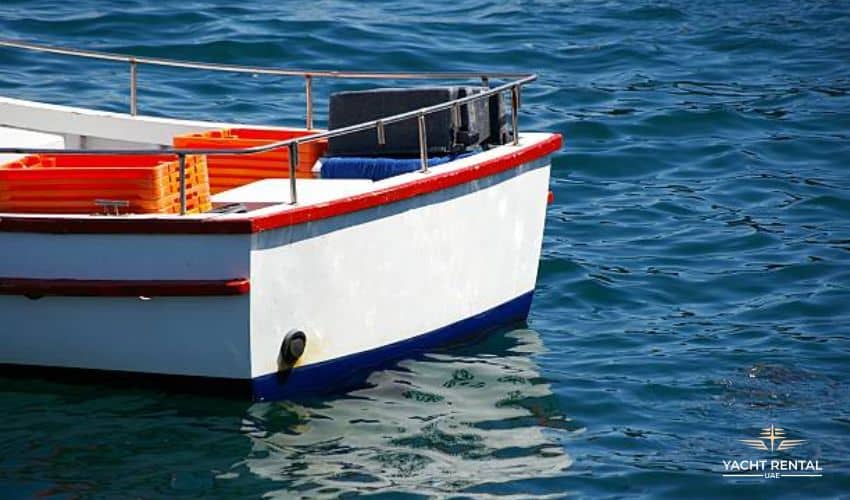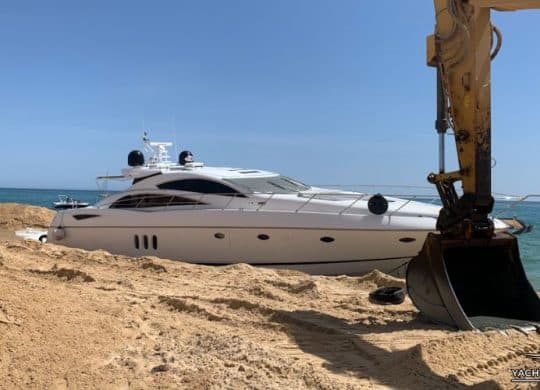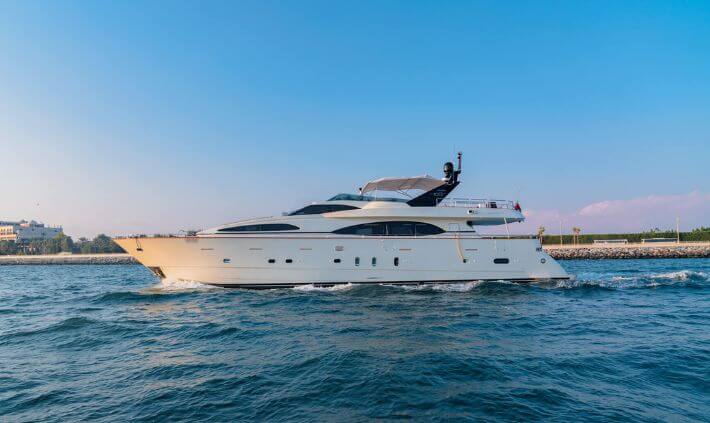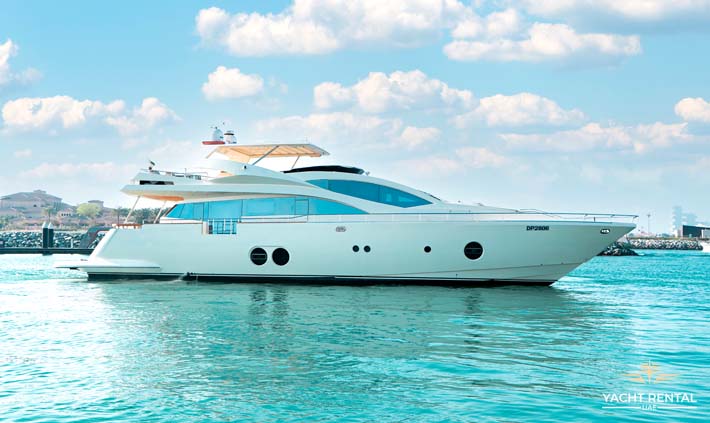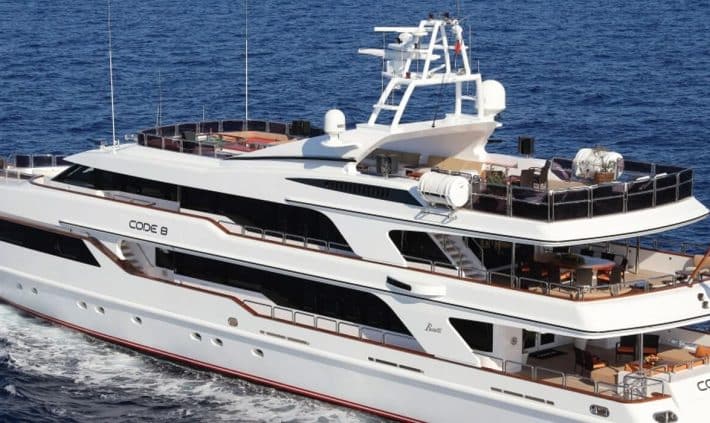Stern vs. Transom vs. Aft
Many people use these terms interchangeably, but they have distinct meanings in the maritime world. Using the correct term signals experience and helps you communicate with precision, especially during docking or close-quarters maneuvering. A clear way to separate these concepts is to think about them as a place, a surface, and a direction.
Quick Reference Table
| Term | What It Is | Example of Use |
| Stern | A place: The entire rear section of the boat. | “Secure the fenders to the port side of the stern.” |
| Transom | A surface: The flat or curved back wall of the stern. | “The boat’s name and hailing port are on the transom.” |
| Aft | A direction: Movement toward the boat’s stern. | “The fuel tank is located aft of the main cabin.” |
| Astern | A direction: In the water, directly behind the boat. | “The dinghy was towed astern.” |
Important Components at the Stern
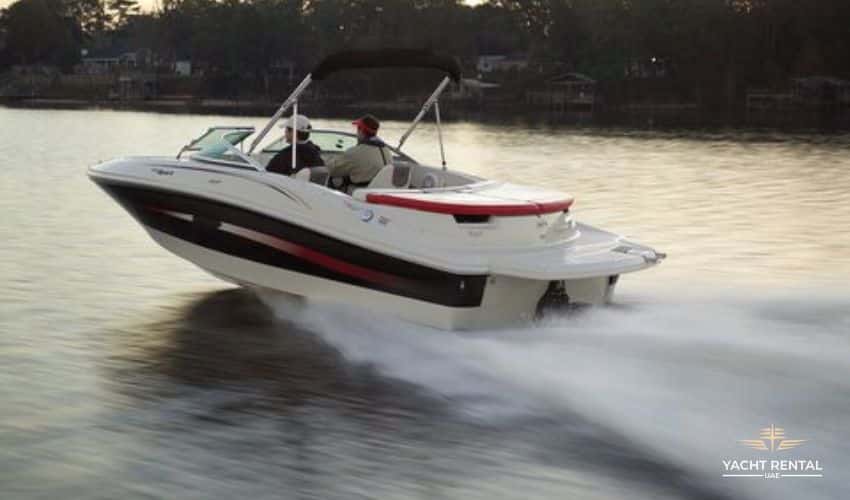
The stern is a hub of critical functions. Its design incorporates propulsion, steering, and utility features that are fundamental to the boat’s operation.
- Propulsion System: On many powerboats, one or more outboard motors are mounted directly to the transom. For inboard boats, the stern is where you will find the rudder and propeller beneath the hull.
- Steering System: A small boat might have a tiller connected directly to the motor or rudder at the stern. On larger vessels, the steering gear is connected to the helm station from this area.
- Utility and Access: This area often includes features for safety and recreation. Swim platforms provide easy access to the water, while boarding ladders, transom doors, and stern cleats for mooring lines are also common.
How Stern Design Affects Your Boating
According to Chapman Piloting & Seamanship, the shape of a boat’s stern is not just for aesthetic purposes; it has a direct impact on performance, stability, and practicality. An experienced mariner can tell a lot about a boat’s purpose from the design of its back end.
The Transom Shape Matters
Flat Transom: This design is simple and cost-effective to build. It maximizes cockpit space and provides a wide, flat surface ideal for mounting outboard motors or swim platforms. You find it on many small fishing boats, pontoons, and tenders.
Reverse Transom: This modern style features a transom that angles forward from the waterline to the deck. It creates a longer waterline length, which can increase hull speed. A downside is that it can make judging your distance from a dock a bit tricky when backing into a slip.
Classic or Counter Stern: This design has a long, elegant overhang that extends well past the rudder post, common on traditional sailing yachts. It offers excellent buoyancy in a following sea (waves coming from behind), but the long unsupported section can be prone to “wave slap.”
Tip For Docking
I once watched a captain of a brand-new express cruiser with a stylish reverse transom misjudge the pivot point. The upper corner of the stern swung in faster than expected and made contact with a piling, leaving a deep gash in the gelcoat.
Always learn how your specific stern shape behaves. Before your first docking attempt in a new boat, practice in open water to see how it pivots when reversing.
Stern Shape and Your Wake
The shape of your stern also molds the wake your boat leaves behind. A wide, flat transom tends to carve out a steep, crisp wake, which is desirable for water sports like wakeboarding. A rounded or “cruiser” stern, often found on displacement hulls, creates a smoother, gentler wake that is less disruptive to other boaters.
Final Words About the Back of a Boat
Knowing nautical terms is about more than just vocabulary; it is about operational safety and clarity. In a critical moment, there is a big difference between telling a crew member to “grab the line on the transom” versus “look astern for that channel marker.” Precise language on a boat prevents confusion, reduces risk, and ensures everyone onboard operates as a capable team.
Also Read: What is the Beam of a Boat
Frequently Asked Questions (FAQs)
What is the opposite of the stern?
The opposite of the stern is the bow. The bow is the very front part of the boat’s hull, designed to cut through the water. All directional terms are relative to the bow and stern; for example, “forward” means toward the bow.
What is a poop deck on a boat?
A poop deck is a raised deck on the stern of a boat. The term originates from the age of sailing ships. The poop deck formed the roof of a cabin at the aft part of the vessel and was a good vantage point for the ship’s master to command the crew.
What are the port and starboard quarters of a stern?
The port and starboard quarters are the back corners of the boat on either side of the stern. If you are facing forward, the port quarter is the rear left corner, and the starboard quarter is the rear right corner. These terms are often used when describing another vessel’s position relative to yours.

